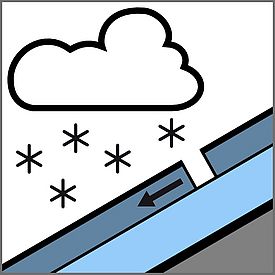
What?
Characteristics
The avalanche problem is related to current or most recent snowfall. The amount of additional loading by new snow onto the existing snowpack is the crucial factor of the new snow problem. How critical the loading is, depends on various factors such as air temperature, wind or characteristics of the old snow surface.
Avalanche type and trigger
- Dry‐snow slab avalanches
- Dry loose snow avalanches
- Natural and human triggered avalanches possible
Where?
Spatial distribution
In general, a widespread presence and often on all aspects.
Position of the weak layer in the snowpack
- Dry-snow slab avalanches: Typically between new snow and old snow or within the new snow layers. Occasionally slightly below the old snow surface. In that case, the problem “persistent weak layers” additionally prevails.
- Dry loose snow avalanches: Start at the surface but the avalanche flow can erode deeper into the snowpack.
Why?
Release characteristics
- Dry-snow slab avalanches: Failure of newly-formed weak layers within the new snow or due to additional loading by snowfall on existing weak layers (old snow surface or below).
- Dry loose snow avalanches: Lack of cohesion between the new snow particles.
When?
Duration
Typically during snowfall and up to a few days after.
How to manage?
Identification of the problem in the field
The new snow problem is fairly easy to recognize since it affects most of the terrain but the characterization of the associated danger can be very tricky. Consider critical amounts of new snow and recent avalanche activity.
Travel advice
- Dry-snow slab avalanches: Wait until the snowpack has stabilized and the weak layer has gained strength.
- Dry loose snow avalanches: Danger of being carried away by small avalanches is more important than danger of burial. Consider consequences in extreme terrain.